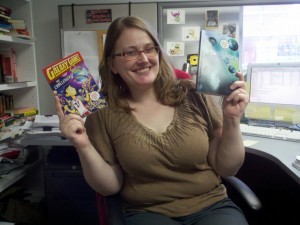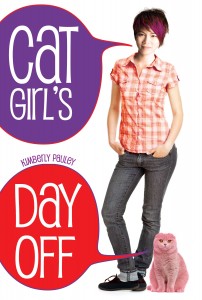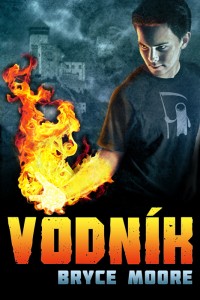I don’t know that we’ve ever discussed the concept of the Magical Negro here before, or its equivalent in American storytelling with Asian and Native American characters, and I think we need to. With Tu’s emphasis on protagonists being characters of color, I don’t get as many submissions nowadays using this old stereotype/trope, but it’s one that I’ve seen a lot of in past years because it’s so common, an easy way to add diversity that has a subtle racism in it because of the way it privileges the white main character over the person of color who is helping him (and it’s usually a him).
I just ran into this great post by Nnedi Okorafor from 2004—that you should go read in its entirety—that sums up the trope quite nicely:
- He or she is a person of color, typically black, often Native American, in a story about predominantly white characters.
- He or she seems to have nothing better to do than help the white protagonist, who is often a stranger to the Magical Negro at first.
- He or she disappears, dies, or sacrifices something of great value after or while helping the white protagonist.
- He or she is uneducated, mentally handicapped, at a low position in life, or all of the above.
- He or she is wise, patient, and spiritually in touch. Closer to the earth, one might say. He or she often literally has magical powers.
Think about even some recent movies and you’ll see this trope at work. (Movies are easy comparisons for me as shortcuts, because they tend to be easier touchstones for a larger audience.) Cowboys and Aliens, anyone? I was enjoying the complicated character interactions of C&A right up until the end when (SPOILER ALERT) a certain important character dies, which ruined the entire movie for me. Not quite a Magical Negro in that situation, but related to it. American martial arts movies from the 80s and 90s had plenty of Magical Asians teaching young white kids karate or kung fu (yes, Karate Kid, awesome as it is, falls into this).
Sometimes the trope is fairly benign. So let’s look at Karate Kid. After quite a bit of focus on Daniel, eventually there’s a bridging of the cultural gap between Mr. Miyagi and Daniel—eventually Daniel learns about Mr. Miyagi’s past and we come to understand Mr. Miyagi as a person, which deepens the character development and I think changes the dynamic from one in which his existence in the plot is only to help the main character. Daniel has at least a tiny bit to offer Mr. Miyagi as well, in the form of friendship to a lonely old man. The balance is still in Daniel’s favor, but not as severely as in other stories that use this trope.
In Okorafor’s post, she examines Stephen King’s use of this trope, and she also notes that
King is not a racist. The Talisman, The Stand, The Shining, and The Green Mile are superb novels and I do think that there was good intent behind the making of the characters I’ve mentioned. Nevertheless, these characters are what they are and King does benefit from that fact. Magical Negroes are always interesting, being magical and mysterious, and they make things happen. When a Magical Negro pops up, the story crackles and pops.
The trope is a trope because it can make a story work. Yet just because it’s something that works doesn’t mean it’s something we shouldn’t try to avoid when we can, especially because the trope can be pretty caustic, too—think about, especially, storytelling about Native Americans. Last of the Mohicans and Dances with Wolves are pretty good examples of When Tropes Go Bad: the Native Americans almost always die to leave the land to their white inheritors, and the power dynamic is always tipped in favor of the white protagonist as inheritor of the virtues of the Native Americans. “Native Americans don’t live here anymore” seems to an underlying message from stories like this. The controversial book Touching Spirit Bear comes closer to home for those of us in the YA community.
(Okorafor’s post over on Strange Horizons covers a lot of interesting and important territory on this subject, so go read the whole post.)
How to avoid the Magical Negro trope, or at least the worst version of it? As I think about it, the Magical Negro is kind of a subtype of the Guru character who comes to help the protagonist on his journey. In fantasy, Gandalf is the perfect example of the Guru character. Especially in The Hobbit, Gandalf exists to help, teach, and guide. We don’t know much about him—he’s just this mysterious magical being who helps Bilbo set off on his quest. Gandalf’s role in The Lord of the Rings is expanded a little, and his relationship with Sauron and their backstory more important, but Gandalf is still very much in the role of helper to the main characters, the one who dies so that others can live (getting away from the Balrog)—he just happens to be powerful enough to come back as Gandalf the White, and then AGAIN help the main characters win by bringing reinforcements to Helm’s Deep, among other feats.
But when the Wizard becomes the Magical Negro, we add a racial dynamic to a relatively tired old trope (after all, even if it works for Gandalf, it’s been done so many times) that, especially when the older POC is teaching a young white kid, implies a symbolic inheritance/transference of wisdom and power—especially, as we already talked about, when it comes to stories involving Native Americans in the 1800s.
Occasionally I hear white writers, especially, say things like, “How can I add diversity to my stories, then? It seems like you can’t win. When I do add diversity, I get accused of playing to stereotypes”—the Magical Negro being one, the Black Guy Dies First being another.
I think part of of the solution is seeing past the main character as the most important character to the exclusion of other characters. “Helper” characters need to be fleshed out as independent beings in their own right, with their own concerns that don’t always match up to the priorities of the main character, even if the fate of the world is at stake.
I’m currently catching up on Supernatural Season 6, and there was a really great episode about Bobby, the down-to-earth friend of the family who is always getting Sam and Dean out of scrapes both big and small. (SPOILERS AHEAD) At the end of Season 5, Bobby sold his soul to a demon to accomplish some goal that I’ve now forgotten, the end result of which was to ensure that Satan went back in his cage and didn’t destroy the world. Now in the 5th season, Bobby has to deal with the consequences of that deal. Meantime, Dean has some suspicions about Sam being not quite right and wants to air his worries/grievances to his normal confidant, Bobby. But Bobby now has bigger fish to fry. He has to worry about his OWN soul, literally. Yet Dean’s worries are justified and he really does need help, so Dean has to help Bobby so Bobby has the space to help Sam and Dean.
I think that kind of complication of character motivations makes all the difference. Bobby is sort of Sam and Dean’s Gandalf. He’s always sending them off on quests, or in Supernatural parlance, “jobs.” There isn’t a racial dynamic, but Bobby is a “helper” character most of the time. Yet Bobby is a fully-fleshed-out real person, too, who is just as important as anyone else. He’s not lower in social stature, he’s not obliged to help Sam and Dean out of any other motivation other than friendship/a sense of family. He doesn’t simply exist to serve Sam and Dean and then disappear.
ETA: I know this is already long, but Okorafor has a great point in that same post that sums up what I’m getting at quite nicely:
Part of my point was that Magical Negroes have power that, if harnessed for personal intent, would change the story greatly. What would The Green Mile be if Coffey had been more concerned with escaping than helping? What would The Talisman have been if Speedy hadn’t been there for Jack because he was trying to save the talisman himself, because he thought he himself was capable, too? What would have happened in The Stand if Mother Abigail had been more concerned with helping her own folks make it to a better place than the ragtag group that came along? What would all these stories have been if these characters’ destinies weren’t so tied to someone outside of themselves? If they hadn’t been written that way? The answer: the stories would have been more complex, the characters more human, less lapdog.
Making secondary characters more fleshed-out, real people with their own priorities and individual worth, and less a cardboard cutout, won’t automatically prevent them from still being representative of a trope, but I think it can help mitigate the dynamic. And, of course, more stories starring POC as heroes of their own tales is another solution to this problem. Let’s talk about it some more. What do you think?
**By the way, this post was inspired because I followed a link from Nnedi Okorafor’s post on her bust of Lovecraft, the symbol of her World Fantasy Award, which explores Lovecraft’s racism and the legacy of racism we must confront in fantasy. Go read that as well.

 Preparing for a career in publishing
Preparing for a career in publishing One thing we talked about is how the industry itself is working on awareness and furthering diversity among the books themselves and future publishing personnel. Last night, we launched the
One thing we talked about is how the industry itself is working on awareness and furthering diversity among the books themselves and future publishing personnel. Last night, we launched the  These questions are from chapter 9 of the excellent book
These questions are from chapter 9 of the excellent book  Also: I loved that there were several Koreans in my seminar over the course of the day, two in one session alone! After that session, we got to talking about why and how I’m learning Korean, so I wanted to give a shout-out to the excellent
Also: I loved that there were several Koreans in my seminar over the course of the day, two in one session alone! After that session, we got to talking about why and how I’m learning Korean, so I wanted to give a shout-out to the excellent 


 Who’s going to
Who’s going to